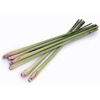
| ||||||||
Thai Food Ingredient GlossaryMore Thai food ingredients: Lemon Grass (dtah-kry): This aromatic citrus-flavored tropical grass is a must for homemade Thai curry paste and many other popular Thai dishes.
If using dried lemongrass stalks, use 2-3 pieces more than the recipe calls for. Soak in hot water for an hour. Powdered lemon grass is also available (visit our online grocery). Two tablespoons powdered spice is approximately equivalent to one fresh stalk. Be careful though because dry lemongrass contains salt. Adjust seasoning accordingly. For soups, try substituting fresh lemon peel if you are in a pinch for fresh stalks.  Palm Sugar: This type of sugar has a rich caramel flavor quite different from cane sugar and is used to make authentic Thai kanom (sweets). It is also added to Thai stir-fries and dipping sauces and should be used in recipes calling for palm or coconut sugar. Palm sugar is made from the sap of the coconut palm flower and is the most used type of sugar in traditional Thai cooking. Palm Oil (nahm meun peut): This inexpensive cooking oil is used daily for frying and flavoring in soups in Thailand. Many farmers grow palm trees (different from the coconut palm) for oil production in Thailand and Malaysia. Substitute a light oil like canola, sunflower or peanut oil if unavailable.
Mature black peppercorns or black pepper are not used much in Thai cooking, except certain regional dishes. White Pepper is used the most commonly in Thai cooking. It is obtained by allowing the pepper berries to fully mature on the vine to bright red. The seeds are then allowed to ferment in a warm place for a few days. The red outside is rubbed off to reveal smooth, round white peppercorns. The resulting ground pepper is speckled black. Shop in our Thai grocery for Thai white peppercorns. Roasted Rice Powder: Make your own rice powder by roasting raw sticky rice in a hot skillet (cast iron is good) or wok over low to medium heat until golden brown for about 12 minutes. Stir constantly so that it does not burn. Grind in a mortar with a pestle or clean electric coffee-grinder until pulverized. Some small pieces of rice may still be visible. Use to make Laab- a delicious type of salad from the North East of Thailand. Shop in our Thai grocery for sticky rice and other Thai ingredients for Laab salad.
To prepare tamarind water, pour warm water to cover 2-3 tbsp. tamarind paste and squeeze to extract the flavor. Discard the seeds and add only the liquid to the sour curry. If you are pressed for time, the seeds may be left in the dish, but warn your diners. Simply add directly to the sour curry, breaking into small pieces. Sometimes fresh sweet tamarind is available, which makes for a very tasty snack.
Main page of Thai Ingredients Glossary A to Z Shop for exotic Thai cooking ingredients in our marketplace |
||||||||

 To grow your own lemon grass: Plant 6 clipped rooted plants in a circle in a large pot, leaving the middle section empty. The plants will multiply and fill in the center as they flourish. In cooler climates, grow outdoors in warm months and indoors during colder months. Allow one year to mature, but you can steal a few pieces by cutting off just what is above ground now and then. You may buy
To grow your own lemon grass: Plant 6 clipped rooted plants in a circle in a large pot, leaving the middle section empty. The plants will multiply and fill in the center as they flourish. In cooler climates, grow outdoors in warm months and indoors during colder months. Allow one year to mature, but you can steal a few pieces by cutting off just what is above ground now and then. You may buy 

 Tumeric or Cumin (cu-min): Tumeric root is used for brilliant yellow color and subtle flavor in Thai curry. It is available frozen or as a dried ground powder. Substitute one teaspoon dried turmeric powder for a half-inch fresh piece. It may be possible to grow at home, but generally it is difficult to find fresh. Shop for
Tumeric or Cumin (cu-min): Tumeric root is used for brilliant yellow color and subtle flavor in Thai curry. It is available frozen or as a dried ground powder. Substitute one teaspoon dried turmeric powder for a half-inch fresh piece. It may be possible to grow at home, but generally it is difficult to find fresh. Shop for 
